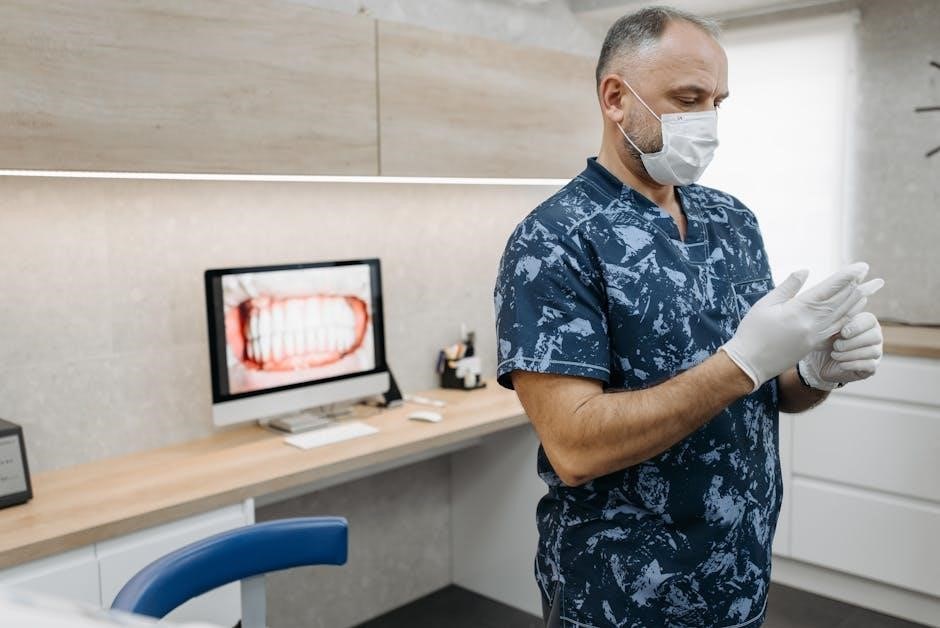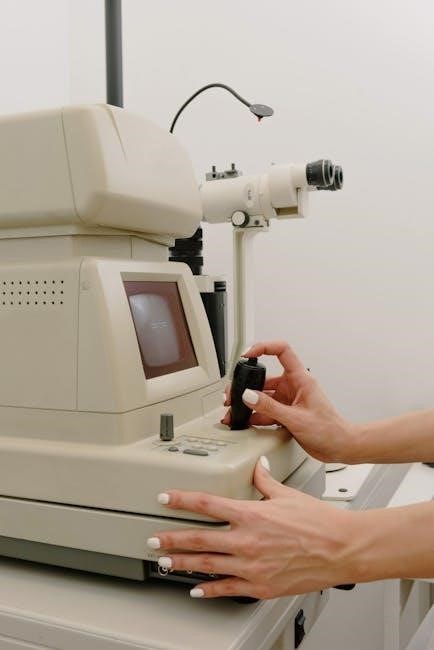The NYS EMT Practice Exam PDF is a valuable resource for candidates preparing for the New York State EMT certification exam. It simulates real test conditions, helping candidates assess their knowledge and improve readiness. The practice exam covers essential topics and provides feedback to identify areas for further study, ensuring confidence and preparedness for the actual exam.
Why Practice Exams Are Essential for EMT Certification
Practice exams are a cornerstone of effective preparation for EMT certification. They provide candidates with a realistic simulation of the actual test environment, helping them familiarize themselves with the format, question types, and time constraints. By identifying knowledge gaps, practice exams allow focused study on weak areas, ensuring a more comprehensive understanding of critical EMT concepts. Additionally, they reduce test-day anxiety by building confidence and improving problem-solving skills under pressure. Regular use of practice exams enhances retention of key information, such as patient assessment techniques, airway management, and trauma care protocols. Ultimately, practice exams are indispensable for refining test-taking strategies and achieving success on the NYS EMT certification exam.

Overview of the NYS EMT Exam Structure
The NYS EMT exam is divided into sections testing patient assessment, airway management, cardiology, and trauma care. It includes multiple-choice questions and practical scenarios to evaluate critical thinking and procedural skills, ensuring comprehensive readiness for real-world emergencies.

Understanding the Exam Format and Question Types
The NYS EMT exam consists of multiple-choice questions and practical scenarios designed to assess both cognitive knowledge and hands-on skills. Candidates are tested on their ability to apply medical concepts to real-life situations. The exam format includes sections on patient assessment, airway management, cardiology, and trauma care, with questions ranging from straightforward recall to complex problem-solving. Time management is crucial, as the exam is timed, and candidates must allocate their time wisely to answer all questions. The practice exam PDF mirrors this structure, allowing candidates to familiarize themselves with the format and question types, reducing exam-day anxiety and improving overall performance. This preparation tool helps identify strengths and areas needing improvement, ensuring candidates are well-prepared for the actual certification exam;
Key Topics Covered in the NYS EMT Practice Exam
The NYS EMT practice exam covers critical topics such as patient assessment, airway management, trauma care, and cardiology. These subjects are essential for EMT certification and real-world application.
Patient Assessment and Management
Patient assessment and management are cornerstone skills for EMTs, ensuring accurate diagnoses and appropriate care. The practice exam tests the ability to conduct thorough patient evaluations, including identifying chief complaints, performing physical examinations, and interpreting vital signs. Candidates are expected to demonstrate understanding of the EMS assessment process, including scene size-up, primary and secondary assessments, and reassessment. Additionally, the exam covers decision-making skills for prioritizing care, such as determining the severity of injuries or illnesses and recognizing life-threatening conditions. Effective communication with patients, including obtaining medical histories and explaining treatments, is also emphasized. These questions simulate real-world scenarios, helping candidates refine their critical thinking and patient management capabilities, ultimately improving their readiness for emergency situations.
Airway Management and Respiratory Care
Airway management and respiratory care are critical components of EMT training, as they directly impact patient survival and comfort. The practice exam evaluates the ability to identify and manage airway obstructions, such as choking or trauma-related blockages. Questions cover techniques for opening airways, including manual maneuvers like the head-tilt chin-lift and the use of suction devices. Respiratory care topics include oxygen therapy administration, nebulizer use, and recognition of respiratory distress or failure. EMTs must also understand how to assist patients with breathing, including bag-valve-mask ventilation and the proper use of supplemental oxygen. The exam emphasizes clinical scenarios, such as asthma attacks, chronic obstructive pulmonary disease (COPD) exacerbations, and carbon monoxide poisoning, to test practical application of skills. Mastery of these concepts is essential for providing effective prehospital care and improving patient outcomes.
Cardiology and Emergency Medical Procedures
Cardiology and emergency medical procedures are cornerstone topics in the NYS EMT Practice Exam PDF, focusing on the identification and management of cardiovascular emergencies. Questions address the recognition of heart attack and stroke symptoms, as well as the proper administration of oxygen and cardiac medications. The practice exam also covers the use of automated external defibrillators (AEDs) and manual defibrillators for cardiac arrest scenarios. EMTs are tested on their ability to interpret basic ECG rhythms, such as ventricular fibrillation and atrial fibrillation, and to initiate appropriate interventions. Additionally, the exam evaluates knowledge of prehospital care for conditions like pulmonary embolism and cardiogenic shock. Mastery of these skills is critical for providing timely and effective care in life-threatening cardiac emergencies, ensuring the best possible patient outcomes.
Trauma Care and Injury Management
Trauma care and injury management are critical components of the NYS EMT Practice Exam PDF, focusing on the assessment and stabilization of patients with traumatic injuries. The exam evaluates knowledge of trauma mechanisms, such as blunt and penetrating injuries, and the appropriate prehospital interventions. Questions address patient assessment techniques, including the use of the Glasgow Coma Scale and the identification of signs and symptoms of head, spinal, chest, and abdominal injuries. The practice exam also covers the management of bleeding control, splinting, and the use of backboards and cervical collars for immobilization. Additionally, it tests understanding of injury patterns related to motor vehicle collisions, falls, and assaults. Mastery of these skills is essential for providing effective trauma care and improving patient outcomes in emergency situations.
Study Tips for Maximizing Your Practice Exam Score
Create a study schedule, focus on weak areas, and review practice exam answers. Use flashcards for key terms and simulate real test conditions to improve time management and reduce stress;
How to Use the NYS EMT Practice Exam PDF Effectively
To maximize the benefits of the NYS EMT Practice Exam PDF, start by setting a dedicated study environment. Begin with a full practice exam under timed conditions to gauge your baseline knowledge and time management skills. After completing the exam, thoroughly review each question, focusing on the rationale behind correct answers and areas where you need improvement. Create a study plan targeting your weaknesses, using the PDF to identify key topics such as patient assessment, airway management, and trauma care. Regularly revisit the practice exams to track your progress and adjust your study schedule accordingly. Consistent practice will enhance your understanding and boost your confidence, ensuring you’re well-prepared for the actual certification exam.
Sample Questions and Answers from the NYS EMT Practice Exam
The NYS EMT Practice Exam PDF includes realistic questions mirroring the actual exam. For example, “What is the first step in patient assessment?” Answer: “Scene size-up and patient safety.” Another question asks, “What is the primary treatment for anaphylaxis?” Answer: “Administer epinephrine via auto-injector.” These questions cover critical topics like airway management and trauma care, providing clear explanations to reinforce learning.
Reviewing Common Exam Questions and Solutions

Reviewing common exam questions and solutions is a crucial step in preparing for the NYS EMT exam. The practice exam PDF includes frequently asked questions, such as those related to patient assessment, airway management, and trauma care. For example, questions about scene size-up, primary survey, and secondary assessment are common. Solutions provide detailed explanations, helping candidates understand correct answers and identify knowledge gaps. Additionally, questions on pharmacology, such as the administration of epinephrine for anaphylaxis, are included with clear rationales. This review process ensures candidates are familiar with the exam format and can apply their knowledge effectively. Regularly reviewing these questions enhances problem-solving skills and builds confidence for the actual exam.
Test-Taking Strategies for Success
Effective test-taking strategies include time management, stress reduction techniques, and prioritizing high-weight questions. Practice active reading and educated guessing to improve scores and build confidence.
Time Management and Stress Reduction Techniques

Effective time management is crucial for success on the NYS EMT exam. Allocate a set amount of time for each question to avoid spending too long on one. Prioritize questions you’re confident about and return to challenging ones later. Stress reduction techniques, such as deep breathing exercises, can help maintain focus. Stay hydrated, take short breaks between practice sessions, and ensure adequate rest before the exam. Visualization of success can also boost confidence. Practicing under timed conditions using the NYS EMT Practice Exam PDF helps build familiarity with the exam format and reduces anxiety. By mastering these strategies, candidates can approach the exam with calmness and clarity.
